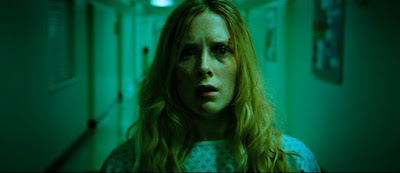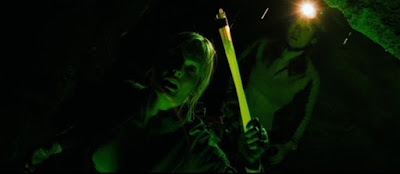A Girl Walks Home
Alone at Night (2014) Just when you thought you’ve seen every spin on the
vampire genre, along comes this assured feature film debut by writer/director Ana
Lily Amirpour. With a Persian language soundtrack, Iranian Setting (filmed in
California) and magnificent black and white cinematography, Amirpour makes a
lasting impression. Arash (Arash Marandi) ekes out a meager existence in the
slums of Bad City, where drugs and prostitution are commonplace. Sheila Vand
plays the title character (the word “vampire” is never used) who strolls the
streets and alleyways, and preys on the denizens around the slum. She’s highly
selective about her choice of victim, however, dispatching those who cause
suffering to others, or fail to contribute to the community. This hypnotic film
might be deliberately paced, but don’t confuse that with boring. Amirpour takes
the time to introduce us to the residents of Bad City, creating a world that’s
bleak, immersive and believable.
Rating: ****. Available on Blu-ray, DVD and Netflix
Streaming
Ginger Snaps (2000) Here’s
a rarity: a clever horror/comedy with smart teen characters. Director John
Fawcett and writer Karen Walton draw parallels between adolescence and
lycanthropy. Sisters Brigitte (Emily Perkins) and Ginger (Katharine Isabelle)
are misfits at their high school, until Ginger begins to change. She starts
noticing guys, smoking weed and acting defiant at home, much to the chagrin of
her parents. But in Ginger’s case, she faces more than just the usual teen
angst and hormonal imbalances after she’s bitten by a werewolf. Perkins and
Isabelle are terrific as siblings that are growing apart, as well as Mimi
Rogers, in a nice supporting role, as their clueless, fashion-challenged
mother. Ginger Snaps loses some
momentum in the final third, with an action-oriented climax and conventional
ending, but the rest is a solid effort.
Rating: ***½. Available on Blu-ray, DVD and Hulu Streaming
The Dark Hours (2005)
Kate Greenhouse stars in this psychological horror film as psychiatrist
Samantha Goodman, a woman wrestling with her inner demons. As she deals with
the reality of a recently diagnosed brain tumor and her cold marriage, she attempts
to soldier on as an objective clinician. After a particularly stressful
encounter with a sociopathic patient, she decides to take some time off to sort
things out, and heads to a secluded cabin (Is there any other kind?), to
rendezvous with her husband and sister. They soon discover an unwanted guest, an
escaped patient who wants to make her pay for his perceived mistreatment under
her care. Although it’s difficult to watch at times, and falls into some unfortunate
clichés (you can guess what happens to the dog), director Paul Fox and writer
Wil Zmak keep things tense throughout, leading to a strong finish.
Rating: ***½. Available on DVD
El Barón del Terror (aka:
The Brainiac) (1962) If you strip
away the superficial differences, the basic story of this Mexican horror flick
wouldn’t have been out of place in a Hammer film. In 1661, Spanish nobleman Vitelius
d'Estera (Abel Salazar) is accused of witchcraft, and burned at the stake.
Before he succumbs to the flames, he vows revenge against those who sentenced
him. Sure enough, he returns 300 years later in a comet that crashes to earth.
The demonic baron is a wonderfully unique and silly creation, with a pulsing
head and forked tongue, which he uses to suck out the brains of his victims. Can
his deadly rampage be stopped? This enjoyable little film exceeded my
expectations with a brisk pace and the conviction to follow through with its
loopy premise. I hope you’ll like it too.
Rating: ***½. Available on DVD and Netflix Streaming
The Devil Bat
(1940) Director Jean Yarbrough’s Poverty Row cheapie has to be seen to be
believed (or disbelieved). Bela Lugosi stars
as mad scientist Paul Carruthers, who vows revenge against a cosmetic magnate
and his family for making millions of dollars off of his inventions. Carruthers
develops an aftershave that attracts giant killer vampire bats that he created
in his lab (unlike the lazy specialists depicted nowadays, those old-timey
scientists did it all). The unconvincing puppets (we’re treated to close-up
shots of a real fruit bat) swoop down on their unsuspecting prey, tearing out their
aftershave-slathered throats. This goofy, but diverting movie tells its story
in just 68 minutes, and falls squarely into so-bad-it’s-good territory
Rating: ***. Available on Blu-ray, DVD and Hulu
The Boogens (1981)
Judging from such an inauspicious title, you probably shouldn’t expect much,
but The Boogens isn’t terrible, it’s
just not terribly good. The filmmakers use a little too much restraint – we barely
see the titular creatures that lurk in a silver mine. Also, nothing much
happens for the first two-thirds of the movie, unless you count spending time
with a bunch of dull people as character development. I applaud the low budget
monster movie trappings, but not the execution.
Rating: **. Available on Blu-ray and DVD
Macabre (2009)
Writer/directors The Mo Brothers prove no good deed goes unpunished. On the way
to Jakarta, a group of friends pick up a young woman wandering alone in the
rain. They’re welcomed into her house, where her mother repays their kindness
with dinner, but the guests realize too late that nothing is at it appears, and
find leaving is much more difficult than they imagined. Macabre starts out on a promising note, but relies too heavily on
relentless gore and a predictable plot. This well made, but ultimately
pointless exercise confuses a “more is more” approach, rather than adopting a
more subtle tact. The deadly serious tone could also have benefited from some
dark humor to cushion the blows.
Rating: **. Available on Hulu
From a Whisper to a
Scream (aka: The Offspring) (1987)
Poor Vincent Price. He deserved better than to be attached to this sub-par
horror anthology, directed and co-written by Jeff Burr. Price plays elderly
historian Julian White, who introduces four tales (the stories range from awful
to mediocre) about a cursed town in Tennessee. Low production values and weak
writing hinder the quartet of tales, about necrophilia and incest, a man who’s
discovered the secret of immortality, a freak show, and Civil War cannibalism. Poe
and Lovecraft’s names are invoked, but it’s tough to see the influence of the authors’
body of work. Even though he’s not given much to work with, Price does his best
with the material. My advice: If you’re craving this sort of thing, see one of
the Amicus anthologies
instead.
Rating: **. Available on Blu-ray and DVD






























